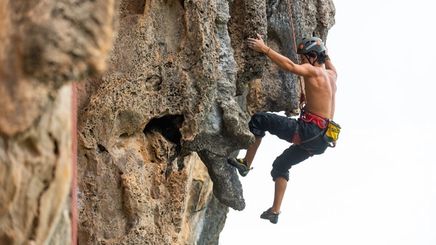
Bored with the same old workout routine? Rock climbing can be a fun and exciting way to push yourself and (literally) reach greater heights. If you’ve always wanted to try it out but aren’t sure where to start, you’re in the right place. Here are some rock climbing tips for beginners, so you can learn the ropes before you hold on to them.
Benefits of Rock Climbing
Certified rock climbing instructor Taz Biagan weighs in on the benefits of rock climbing and what he loves most about the sport. “I love climbing for different reasons, including the community and lifestyle. In its purest form, it really comes down to two things – the challenge and movement. Climbing a rock that inspires you requires a lot of and problem-solving,” Taz says.
Aside from improving your grip and balance, and giving you a good workout, rock climbing makes you a better problem solver. When you’re in a tough spot, you’re forced to think on your feet and choose the best positions to avoid falling. As you progress, you become more equipped to make snap judgments when you’re stuck between a rock and a hard place, literally and figuratively. Read on for advice from Taz.
1. Have an Open Mind
Most guys might be hesitant to try out rock climbing because of the safety risks that come with it, but it’s safer than it looks. “Climbing is a safe sport. With the amount of safety gear and technology used in climbing equipment, you wouldn’t need to worry about the rope or gear breaking. Climbing accidents happen mostly due to climber error rather than equipment failure,” Taz says reassuringly.
There’s no better time than now to and jump right into them, whether you’re afraid of heights or of falling. Go bolder by climbing that boulder.
2. Choose the Right Gear
Your specific gear depends on the climb type, but generally, you can wear your usual workout clothes if they’re not too baggy, fitting, or revealing when viewed from below. “A lot of people start climbing indoors in gyms with artificial climbing walls. All you need are your climbing shoes, a chalk bag, and a harness. If you are a beginner with no gear, you can rent at the gym,” Taz advises.
“For bouldering, since the focus is on climbing difficulty, you won’t need a rope. But you will need a good pair of climbing shoes with sticky-soled sock-like shoes, a chalk bag to hold climbing chalk (similar to what gymnasts use) to prevent your hands from sweating, and a crash pad to protect you from falling.”
“Route climbing, on the other hand, requires more gear. You’ll also need a climbing harness to attach yourself to the rope, a belay device, which is a braking device that uses friction on the rope to catch a fall, and other climbing hardware,” Taz says.
Gear up with Rexona Men Natural Fresh Lime Cool Antiperspirant Deodorant Roll-On that naturally freshens your underarms through dryness protection and long-lasting scents so you can reach for rock after rock with .
3. Find a Climbing Gym that Suits Your Needs
With rock climbing becoming popular, you won’t have a hard time finding a gym. Choose one near you to make it easier to maintain a regular schedule. “For beginners, find a climbing gym most convenient for you to get to, as your improvement relies on how much time you spend climbing,” Taz says. Two to three times a week should get your body used to the demands of climbing and and skin.
Make sure you do a quick background check and research potential instructors, so you get the proper training you need to progress. “Look for reputable climbing instructors with years of outdoor climbing experience and certification to ensure you learn properly and safely,” adds Taz.
4. Mind Your Footwork
Rock climbing might look like a task for the arms and torso, but you’ll need total body coordination to optimize your movements. On your first climb, your footwork will be a mess but don’t sweat it.
“One of the most important techniques is using footwork to save arm and finger strength. Learning to climb as efficiently as possible and using your power for the climbing crux (difficult sections) is key to climbing more difficult routes and boulders,” says Taz.
When the path gets tough, keep your confidence and composure with a deodorant that’s got your back. Rexona Men Quantum Dry Roll-on Antiperspirant Deodorant prevents sweat and odor for up to 48 hours so you can power through your climb all day, whether at the gym or outdoors.
5. Practice Silent Feet Exercises
To get your footwork from sloppy to fancy, practice silent feet exercises, which involve getting your feet to make as little noise as possible when climbing. "Whether on steep or vertical terrain, start with your hips close to the wall. Concentrate on how accurately you step on footholds. When your feet start banging on the wall, this means your footwork lacks precision,” Taz explains. Silent feet exercises will help improve your ability to step on the footholds more accurately.
6. Don’t Over Grip
The first instinct is to hold on with a death grip when you’re hanging several feet above the ground, but rock climbing teaches you to use your momentum instead of relying on your hands and fingers to do all the work.
“On steep climbs, instead of pulling and locking off on holds to reach for the next one, use momentum instead to help you reach dynamically. You save power when climbing when you flow from hold to hold. The trick is to use just enough strength to keep you on the wall,” Taz advises. The more you over-grip, the faster forearm fatigue sets in.
Rock climbing is hard, but it’s also a lot of fun. Find your own pace and trust the process. The journey to the top is what matters.